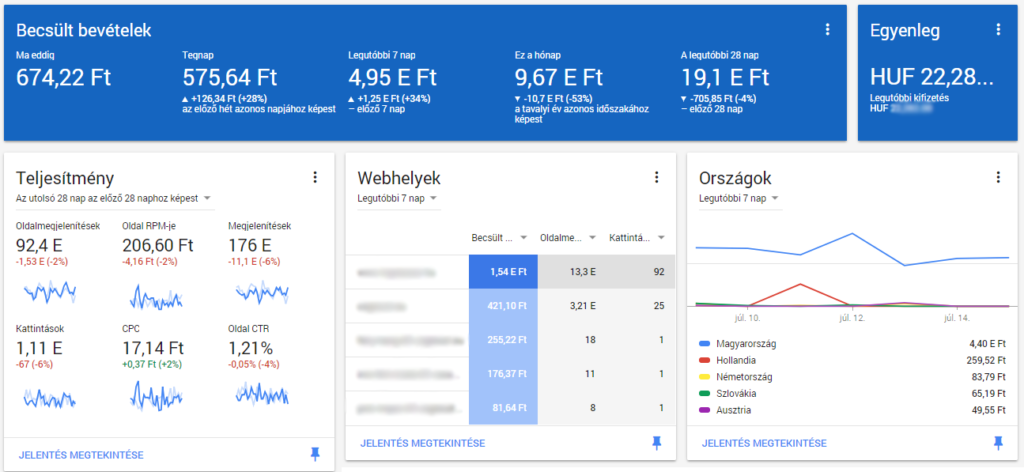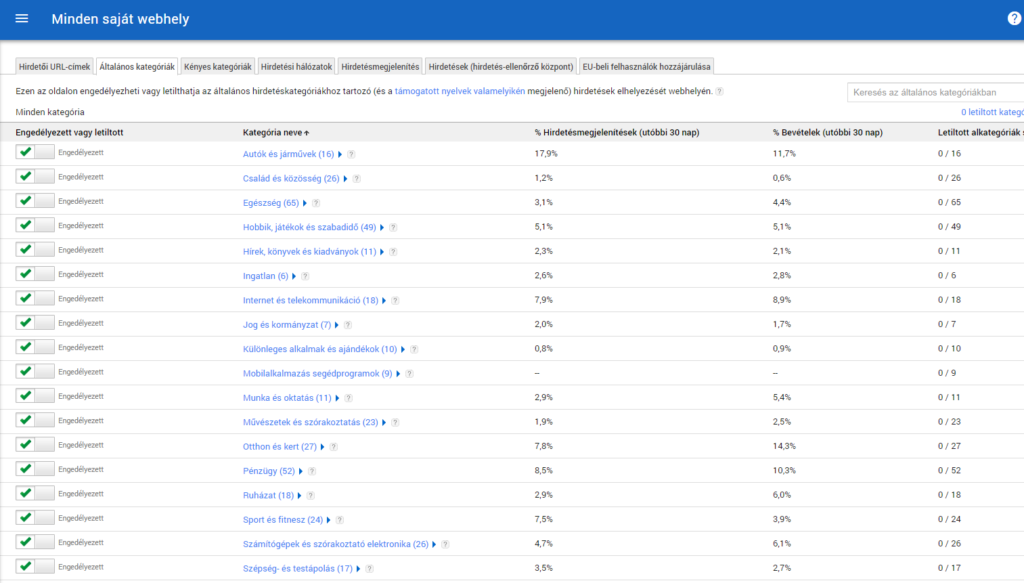Google Adsense optimisation tips | Weboptim
A Google Adsense is a Google product that allows website owners to rent out their website space to advertisements (image, text, video, interactive content) to earn money. These ads are managed, sorted and maintained by Google.
The Adsense system examines the content of a website and sends relevant ads to the site. When the visitor clicks on the ad, the advertiser is paid, part of which goes to the owner of the website displaying the ad.

How can we optimise these ads?
Fix invalid Adsense traffic
From 'Invalid Traffic - AdSense for Content' sometimes a negligible amount, but sometimes a significant source of income.
According to Google, "Invalid click activity includes any click or display that could artificially increase an advertiser's costs or display revenue and that we may choose not to charge the advertiser for. This includes, but is not limited to, clicks and impressions generated by advertisers when they click on their own ads, automated click tools, robots or other deceptive software.
What can we do?
Google offers some tips such as:
- avoiding low quality traffic sources
- monitoring of implementation
- and avoid the temptation to click on your own ads
Content! Google will penalize you if your site contains more ads than content. Be careful to balance the two, as this can affect your audience.
Watch your social media traffic - Adsense doesn't like it. Google prefers to give access to visitors from search engines or sub-pages. It particularly dislikes paid traffic that is paid for separately on different platforms (e.g. paid posts in Facebook groups or paid retweets.)

Category blocking
Blocking or unblocking Adsense categories can affect revenue.
By default, all "safe" categories are marked as available, and risky categories (e.g. gambling) are unchecked. It is likely that these settings have been left as they are.
Because we trust Google to choose the best ad for every visitor to the site. This is an optimistic point of view. But not very realistic.
We can think that by displaying all available ad categories on the website, we can increase the competition for advertisers.
Some categories have higher CPCs, while others have higher CTRs. High RPM results in high CTR and high CPC. But one does not work without the other.
Let's take a look at the 'Allow&Blocks Ads/Allow and block ads' to check which categories are performing badly. Categories with a lot of impressions but little revenue are the ones we can try to turn off, at least temporarily.

Smart pricing for higher CPCs
Many advertisers are satisfied with Google Adsense's intelligent pricing algorithm. This algorithm tries to ensure that it is worthwhile for advertisers to advertise on the network.
This means that whenever possible Google will track advertisers' conversions. Sites and pages that may result in higher conversion rates will receive higher CPC bids.
Unfortunately, only clicks are visible to the viewers, not conversions. Therefore we cannot target specific ad categories or advertisers to improve quality in Google's eyes. What we can do is try to make it worthwhile to give better bids and higher CPCs.
Individual channels
Custom channels can be used to create ad groups or placements that can be targeted directly to advertisers. For advertisers, this is a capability, increasing competition for advertising space.
Anchor and in-flow ads
Every website owner knows - above the fold is gold. But it's fool's gold.
Above-the-fold ads are often the first thing a visitor sees when they arrive on the site. The ads are attractive. But the visitor is not here to see the ads, and we can't afford to forget that. The visitor wants to see the content.
Suppose a visitor arrives at a website that promises great content. Assuming we're doing everything right, the visitor will see a relevant ad and want to click.
But he came for the content. Even if the offer is relevant, if the content is as good as it needs to be, it will keep scrolling. And by the time you're done, you might forget about the ad.
What should we do?
Anchor ads follow users as they scroll, while in-flow ads contain exit points for content. Keep in mind that anchor ads can result in invalid clicks on mobile, so do not use them there.
Optimise to size
Depending on your website theme and settings, you can create different layouts on different devices.
Responsive sites often put ads in the wrong place on mobile, but for example a sidebar ad unit in the mobile version will appear at the bottom of the post. So we can hide ads that perform worse on mobile. Specify a separate mobile ad set that only appears on a mobile device and is optimised for mobile layout.

Extended geographical targeting
Some countries have higher CPC indicators, e.g., UK, US, Canada, etc..
Use asynchronous Adsense code
In 2015, Google introduced asynchronous ad code, which helps publishers reduce page load times in ad units.
Try more ad styles
Choosing the right ad style will help improve the visibility of your ad and reduce the chance of users looking through it immediately.
There are 3 main strategies:
- for blended ads, create an ad with the same background and border as the website background, this works well for sites with a white background
- for complementary ads, use colours that already exist on the site but do not exactly match the background where the ads are placed
- and for contrast ads, choose colours that stand out against the background colour of the website. This style is most appropriate for dark sites
Try more ad sizes
As a general rule, wide ads tend to perform better than tall ads that interrupt the user from reading.
Try more placements
To do this, we need to know where users spend their time on your website. Just because an ad setting works well on a website for, say, a technology newspaper, doesn't mean it will work well for other topics. Likewise, just because it works on the home page, it may not be the best setting for each sub-page.
Most of the time you will see ads in the header, sidebar, within content or below the content. The only way to know which is the best performing space is to set one, then switch and measure the performance against the previous setting.
Installing more advertising units
You can choose to display more than one ad unit on the website, as this increases the likelihood that a user will click on at least one of them.
Use a link unit in smaller places
Link units are a little different from content ad units: they display a list of topics relevant to the content on the site, and when the user clicks on the unit, it takes them to a results page where several ads are displayed, with payment being made when the user clicks on these ads.
They are very distinctive and therefore more likely to trigger action.
We use both text and picture ads
Google Adsense allows you to display text only, image only or combined (image + text) ads.
Google specifically recommends that we allow both display and visual advertising to the network to maximise revenue potential.
If you disable text or image ads, you can effectively remove around half of the space-intensive advertisers - resulting in a significantly lower revenue return.

Do not use too many filters
Adsense allows advertisers to filter ads by URL or category. This can be useful if there is a conflict of interest or if the advertiser does not wish to appear on the page for any reason.
Even though Adsense allows viewers to filter up to 200 different sites, it is advisable to keep this list as short as possible. Filter only what is absolutely necessary.
Use page numbering
Since Adsense does not allow automatic ad updates, the displays themselves must be set to use the latest content.
If the text entries are too long, it is a great idea to set page numbering so that the user can click on the link to view the next page.
This has two advantages: From the user's perspective, it eliminates the need for endless scrolling and breaks down the post into more consumable manageable chunks. From an ad optimisation perspective, this is effective because a new ad can appear every time the page is refreshed.
A/B testing of advertisements
It's difficult to determine which combination (style, size, location...) is right for the website and users. A/B testing allows you to stop guessing and get actual data to make a decision.
In Google Adsense, you can perform A/B testing with 'Experiments' by defining your own experimental parameters. Within the test, it is possible to choose how to distribute traffic between the test versions, although it is better to let AdSense take care of this.
Automate the testing of ads
Imagine you want to test 3 different ad units, with different ad styles, sizes and locations. This is where automated testing comes in. The AdPushup helps advertisers automate the whole process.